Mark V Male Tank 9199
This surviving WW1 British Mark V tank 9199 can be found at the Tank Museum, Bovington, Dorest, BH20 6JG, England. Their website is tankmuseum.org.
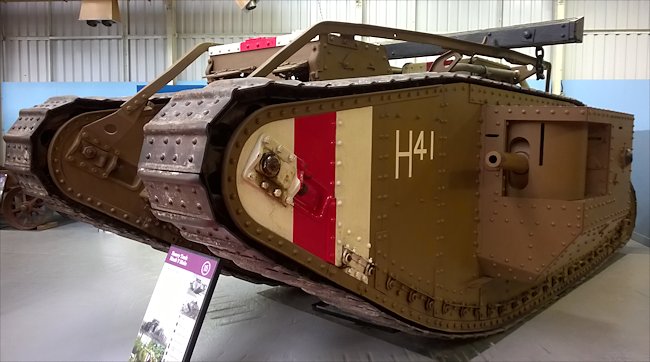
WW1 British Mark V Male Tank at the Tank Museum, Bovington, Dorest, England. It was in action at the Battle of Amiens where its commander was awarded the Military Cross.
Although similar in appearance to earlier British Tank models the Mark V was a much better tank. It had a more powerful engine and was easier to drive. It was equipped with the new Ricardo six-cylinder engine and Wilson's epicyclic steering system which meant that one man could handle all the controls, compared with four in the Mark IV.
Among the new features was a rear cab for the commander, complete with signalling apparatus and a rear machine-gun position. The Bovington Tank Museum's Mark V Male tank also carries an unditching beam, which was first introduced in the Mark IV. This would be used if the tank got stuck in mud - chained to the tracks it was drawn under the tank and gave it something solid to grip.
This Mark V Male tank is shown in the Markings of 8th (H) Battalion, Tank Corps at the time of the Battle of Amiens (8 August 1918). Commanded by a young officer named Whittenbury this actual tank took part in the battle and its young commander was awarded the Military Cross.
It still required a tank crew of eight. They were armed with two 6 pdr guns (57 mm) and two Vickers machine guns. The maximum armour thickness was 12 mm. They were in service with the British Army from 1918 to 1923. The Metropolitan Carriage, Wagon and Finance company of Birmingham built this tank.
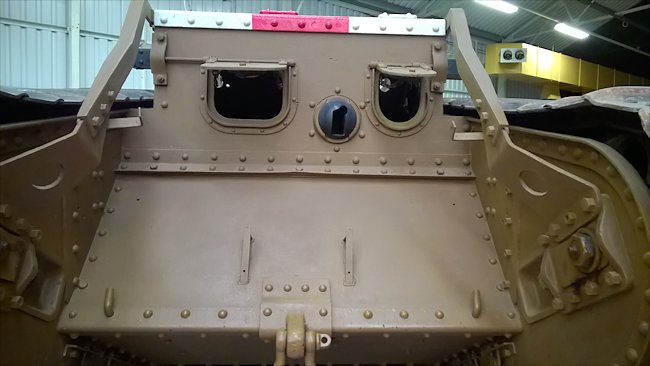
The Mark V Male Tank had a large porthole and a small porthole at the front of the tank unlike earlier models of the tank where they were symmetrical.
When did the British Mark V tank go into battle?
The battle of Hamel in July 1918, was where the British Mark V tank first saw action, before playing an important role in the battle of Amiens and the 100 days offensive that led to the armistice in November 1918 on the 11th hour of the 11th month.
The design team had intended the British Mark V tank to be an entirely new in conception, but it ended up as a organic upgrade development to the British male and female Mark IV tanks. Externally, the new tank looked very similar to its predecessors. It was inside that the differences became apparent
There was a totally new engine designed by Harry Ricardo. It produced 150hp, rather than 105hp available to the drivers of the British Mark IV tanks. It had a brand-new transmission which meant that the tank could now be driven by one man rather than the four required on the previous British tanks. There was no real change in the armaments of the tanks apart from Lewis guns being used instead of French Hotchkiss machine guns.
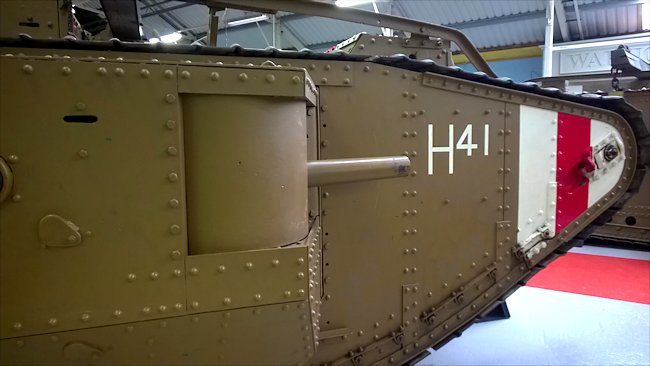
The WW1 British Mark V Male Tank
During the battle of Amiens in the summer of 1918 the British Mark V tanks made their name, when virtually the whole British tank corps was sent to support a major offensive that took place between the 8th and 11th August 1918. German general Erich Ludendorff prescribed this battle as a black day for the German army. Over 340 British Mark V tanks took part in the battle of Amiens. They proved a vital element in the smashing of German defensive forces.
The American and French armies also equipped their armoured units with the new British Mark V tank. The Allied intervention force in North Russia use this tank on the side of the White Russians. Many of them were captured and ended up in Soviet hands.
The British male Mark V tank had a crew of eight. It weighed 26.3 tonnes. It had a maximum speed of 4.6 mph and a maximum range of 45 miles. It could carry 93 gallons of fuel, but consumes 2.06 gallons of fuel per mile. It was a very thirsty tank. It could cross a trench that was 10 foot wide.
One of the ways to tell the difference between a Mark V tank from the IV tank was the presence of a very distinctive rear. A light tanks, British, American and French, were starting to display an identification mark on their tanks. This was to prevent friendly fire. It consisted of three bands of colour: white, red and then white. This identification mark was also used on British tanks during World War II.
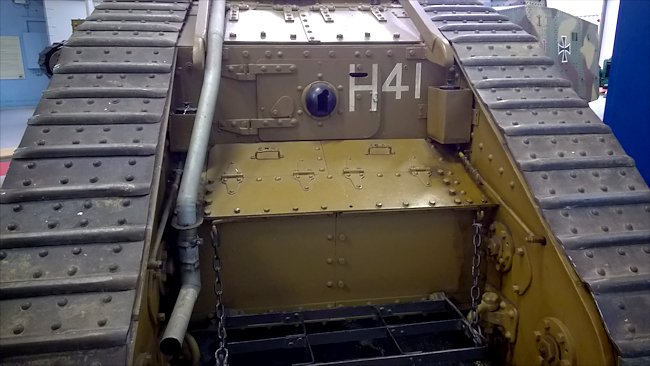
The WW1 British Mark V Male Tank rear hatch had a machinegun ball mount as well as a pistol port covered by a swivel cover.
Tank crew shoot down German plane
Tank Gunner W.L.M. Francis' tank got knocked out early on in the battle. The tank crew took out the guns and carried them with them as they made their way back to their own lines. A German plane come over and in those days, they used to fly very low. Gunner Francis decided he was going to have a go at shooting it down with his tank' Lewis Gun. His officer told him not to be such a so-and-so fool, he'd get his head blown off and that he should get down. When this plane came over again Francis poked the gun up and let fly. He riddled the plane with bullets and forced the plane down. He was award the Military Medal, a very high honour and given a months leave.
It is no longer a runner
This Mk.V tank was a fully working mobile exhibit until the 1990s when it was found the frame plates that hold the road wheels / rollers were starting to crack and would need to be replaced and therefore the decision was made to keep it intact as a genuine original rather than progressively restored with new parts. There is Pathe news reel footage showing British armoured fighting vehicles like the Comet and Centurion putting on a display in 1954. At the end of the film the Bovington MkV drives infront of the crowd. It aslo demonstrated the telegraph arms working on the top of the tank and the way the crew used pidgeons to send messages back to HQ.
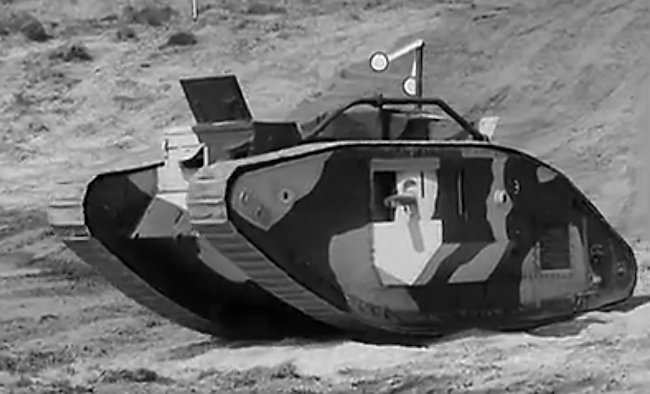
The Bovington Tank's history - Friends of the Tank Museum research
In The Tank Museum's collection resides Hilda, a Mark V tank commanded at the Battle of Amiens by Harold Whittenbury, in which he won a Military Cross. The Tank Museum's Mark V Since the 1920s Mark V number 9199 had been used by the Bovington Garrison as a general purpose vehicle for towing and recovery. Passed to The Tank Museum in 1949 and maintained in running order, for decades it was believed to have been a training machine that never left Britain.
This all changed in 1985. In preparation for the Royal Tank Regiment's Standards Parade the tank received another overhaul, including stripping and repainting. As paint layers were removed 'H41' became visible on the bottom, wartime layer. This crew number revealed 9199 was in fact a combat veteran used by the 8th Battalion, Tank Corps.
The Tank Museum's Archive soon uncovered three separate Battle History Sheets, showing it had fought on the 23rd August, the 29th September, and first and most significantly, the 8th August the Battle of Amiens. After Whittenbury, H41 had two more commanders; unfortunately we don't know the identities of the rest of the crew so can't say whether they differed.
On 23rd August, tank and crew were commanded by Second Lieutenant Thomas de Courcy. Their orders were to assist infantry mopping up parties around the village of Herleville, but they were barely needed and fired just 125 rounds of machine gun ammunition in two and three-quarter hours.
H41 and 9199 were engaged again at Bellincourt on the 29th September. This time H41's commander was Lieutenant Thomas Harding. This action was much more intense, lasting just 45 minutes but saw the crew firing 40 rounds of 6 pounder ammunition at machine gun nests and field gun positions. Facing heavy German fire, 9199 was hit on the left idler wheel and Harding decided to withdraw. He was just in time; no sooner had he reached the rallying point than the left track broke, immobilising the tank.
In the care of The Tank Museum 9199 saw use in parades, demonstrations and television productions, but as time passed it became increasingly fragile. This deterioration, plus the knowledge of its true historical significance, contributed to the Museum's decision not to run it again, This is the best way to preserve the tank for future generations.
Action at Amiens - At 8.20am on the 8th August, 9199 carried crew H41, part of 9 Section, C Company, 8th Battalion, into battle, commanded by 26 year old Second Lieutenant Harold Whittenbury. Their job was to support the 46th Australian Infantry Battalion. Whittenbury named 9199 'Hilda: after his sister. Afterwards he filled in a Battle History Sheet, allowing us to tell his story in his own words.
He kept Hilda 'in front of infantry: spotting and engaging German positions before they could inflict losses on the Australians. He was successful, and they were able to advance 'as far as I could observe with no casualties.' (The 46th Battalion lost just 14 men at Amiens.)
Soon 'both 6 Pounders had picked up targets.' The gunners fired on 'small groups of enemy infantry' and 'machine guns firing from clumps of bushes and trees' and Harold joined in using the front Hotchkiss machine gun. Then two German artillery pieces opened fire on the advancing tanks from 2000 yards away. In response Harold drove his tank on a 'zig Zag course and the shells did not get very near' whilst returning fire with his right 6 Pounder.
Later Harold's targets were much closer. He drove Hilda into a ravine, only to discover many German 'bivouacs and dugouts.' He fired on them 'at 40 yards range' and 'observed many casualties'. Another tank and the Australians soon caught up and the Germans 'appeared to surrender without any resistance.'
Then Hilda came under fire from an 'isolated building.' This forced the infantry to 'stop and lie down.' The Germans inside continued to fight, despite being hit by 6 pounder rounds and machine gun fire, so Harold 'charged the side of the building three times but could not push the wall in.'
After 'a few more 6 Pounders at 10 yards range the machine gun fire seemed to cease and the infantrymen got around the building and in it.' Harold and Hilda passed their objective (the Red Line) at 10:15am. He continued 'about half a mile to the Blue Line: to protect the infantry as they prepared to defend the captured ground, then returned to the rallying point. His part in the battle was at an end.
Although Harold and his crew were uninjured, they were 'exhausted' and two of them had been 'rather badly gassed by petrol fumes' They had fired 87 High Explosive and 18 'case shot' 6 Pounder shells, along with 1960 machine gun bullets. In all, Hilda and crew H41 had covered 8 miles in 4 hours, playing a key role in the battle.
Harold Augustus Whittenbury was born on the 31st July 1892 in Manchester, the oldest child of Augustus and Emily Maude. In 1914 he worked as a clerk for George Robinson and Company, a cotton merchant based in Manchester. When war broke out Harold joined the Battalion of Manchester Clerks and Warehousemen, the first of 8 'Pals' Battalions raised in the city. It was fully recruited in 48 hours.
The unit, renamed the 16th Battalion, Manchester Regiment, was sent to France in November 1915. Their first experience of heavy fighting was on the 1st July 1916, the first day of the Somme Offensive.
The battalion successfully captured the village of Montauban from the Germans, but at heavy cost. They saw further heavy fighting on the Somme throughout 1916, then at Arras and Passchendaele in 1917.
In early 1917 Harold, now a Corporal, transferred to the Machine Gun Corps, then joined the Tank Corps to train as an officer. He was commissioned as a Second Lieutenant on the 28th November 1917.
By mid-July 1918 Harold had returned to France and joined C Company, Bit' Battalion for the Battle of Amiens. Afterwards, he was sent to Le Treport to 'rest' until the 26th. After briefly re-joining the company, he was sent to hospital for an unknown reason on the 30th. On the 1st February 1919 his bravery at Amiens was rewarded with the Military Cross.
After the war Harold returned to Manchester and married Lucy Mary Naylor in 1920. They had two children: Hilda Margaret in January 1922 and Bernard Augustus in December 1924. Lucy died aged 77 in December 1976. Harold died in the Trafford area of Manchester in September 1980. He was 88. Tracklink Magazine - Issue 100.
Where can I find other preserved Mark V Tanks?
- Lugansk - Ukraine
- Kharkov - Ukraine
- Kubinka Tank Museum - Moscow, Russia
- Bovington Tank Museum - Dorset, England
- Severodvinsk, Arkhangelsk (Archangel) in North West Russia
- Mk5* - National Armor and Cavalry Museum, Fort Benning, GA, USA (This tank is missing all its armament and is under restoration. It was moved by transporter from Fort Knox to Fort Benning on 15 December 2010. Bovington had a Mark V tank (marked ‘GONE’ in its database) so, given the rarity of the type, it is presumed that this was that vehicle.)
- Source - Pierre-Oliver Buan - http://the.shadock.free.fr/Surviving_Panzers.html
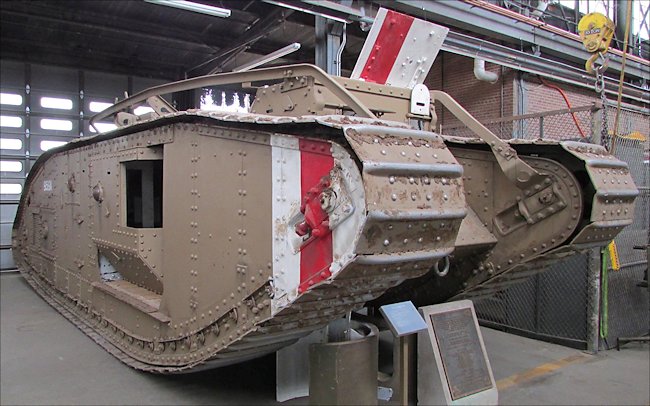
Mark V* No. 9591 of First Platoon, A Company, 301st Tank Battalion, American Expeditionary Force Tank Corps in 1918. She's still looking good after all these years later in Fort Benning, USA
WW1 tank books
